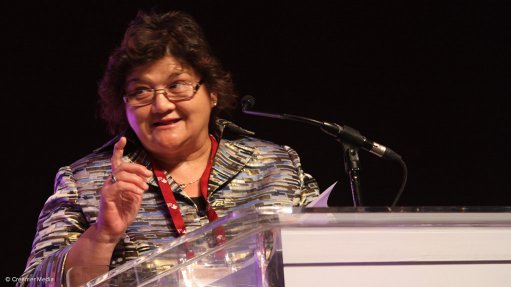
Public Enterprises Minister Lynne Brown
Photo by: Duane Daws
State-owned electricity producer Eskom expects to finalise commercial terms with the New Development Bank (NDB), of the Brics grouping, for a $150-million facility in the next quarter, CFO Anoj Singh reports.
A term sheet has been signed with the NDB and Singh reports that, once consummated, the funding will be used for transmission-related projects.
The utility has acknowledged that the connection of additional renewable-energy and conventional power stations is constrained, in certain regions, by grid infrastructure. There is a particular need to strengthen the grid in the Northern Cape, where there is significant solar and wind potential.
Public Enterprises Minister Lynne Brown highlighted the constraint again in her opening address on Tuesday at the Power-Gen Africa conference and exhibition, in Sandton.
“The Renewable-Energy Independent Power Producer Procurement Programme has been hailed for its success, but at the same time, has highlighted constraints on the alignment of the grid to renewable-energy sources,” she said, adding that “areas that are optimal for wind and solar energy production are becoming increasingly constrained” by these inadequacies.
“Major investment is required in the transmission grid in order to sustain the connection of renewable-energy plants in these areas.”
The same applied, she added, for conventional fossil fuel power plants such as large gas and coal-fired plants.
“In the case of the Waterberg, a major HVDC [high-voltage, direct current] grid connection has been identified as a likely prerequisite for unlocking further large-scale power generation in that area. The cost of such an HVDC scheme is estimated at R13-billion.”
Eskom group executive for transmission Thava Govender stressed that the project was not imminent and had not been included in the current Transmission Development Plan (TDP) covering the period from 2016 to 2025.
“The timing will depend on how coal-power project develop. [But] the current TDP only accommodated Medupi and 500 MW of other coal-related projects,” Govender explained.
It is uncertain whether transmission infrastructure will act as a limiting factor on the development of gas-to-power projects, for which the Department of Energy is expected to issue a request for proposals in the coming months.
Brown reported strong interest, with responses to a 2015 expression of interest (EoI) indicating potential for some 105 GW of new power generation capacity and some 14 GW of short-term power generation capacity.
The EoI covered five categories including projects based on imported gas, domestic gas, power barges and power ships, piped gas and crossborder projects.
“We have received encouraging responses from the market,” Brown revealed, adding that some 57% of the responses related to imported gas, primarily in the form of liquefied natural gas (LNG).
Government is aiming to procure 3 126 MW of gas-fired power generation from independent power producers and a further 600 MW from a public-private partnership involving State-owned companies.
The current expectation is that the Independent Power Producer Office tender will be a bundled request covering gas-fired power plants and the importation infrastructure for LNG.